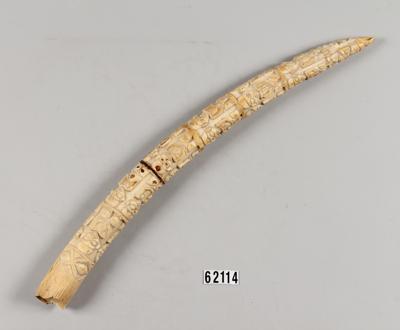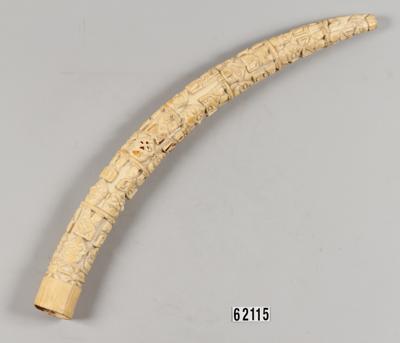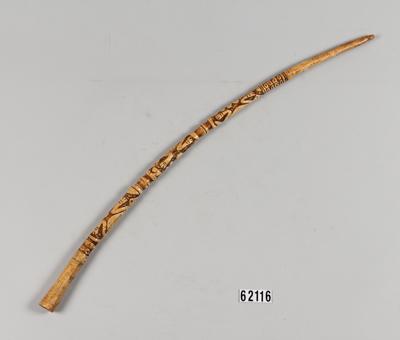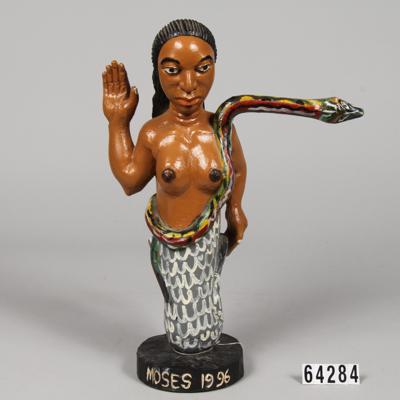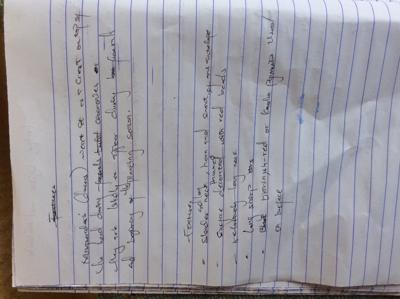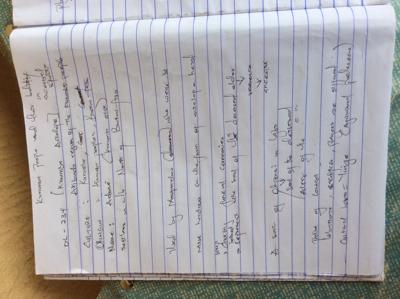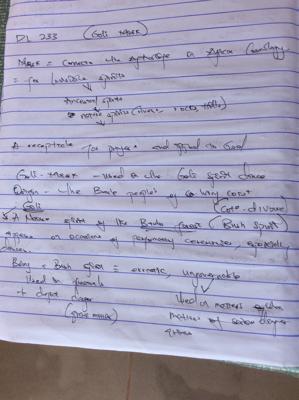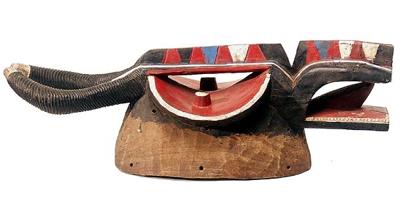THE OBALUFON MASK.pdf
/THE OBALUFON MASK.pdf.jpg)
| Inventarnummer: | DL 316 |
| Andere Nummer: | |
| Titel: | Bronzekopf (ori-olokun) |
| Künstler/Beteiligte: | |
| Herkunft: | West-Afrika |
| Datierung: | ca. 1980 |
| Material/Technik: | Material: Technik: |
| Maße: | Objektmaß: H 558 x B 165 x T/L 230 mm Gewicht: 7638 g |
| Standort: | Dauerausstellung |
| Zugangsart: | |
| Erwerb durch: | |
| Erwerb von: | |
| Erwerbungsjahr: | |
| Erwerbnotiz: | |
| Beschreibung: | |
| Notizen: | |
| Literatur: | |
Bilder
NAME: ORI-OLOKUN (Head of Olokun) [The Divinity of The Ocean]
ORIGIN: WEST AFRICA (NIGERIA)
CULTURE: EDO/YORUBA
OVERVIEW:
Deities, better known as Orisha (or Orisa) in the Yoruba language, are supernatural entities, who work in tandem with Olodumare, the divine and supreme entity in the Yoruba cosmology/ spirituality in checking that the natural laws are well kept.
Olokun is therefore a deity in Yoruba cosmology/spirituality, who manifests itself through water. It is the deity with the absolute authority over water, sea, ocean, etc. Water is naturally, one of the four revered elements across most African cosmological systems, the other three being fire, earth and wind. It serves as a panacea for purification, healing and regeneration. It is also used in communicating to the supreme deity, in cases of extreme need.
The Ocean or sea, which is the abode of Olokun is notably, the source of all wealth in Yoruba cosmology.
FUNCTIONS OF OLOKUN:
The Olokun occupies a prominent place in the pantheon of Yoruba divinities. It is the sustainer of sea life, and an abode of wealth and protection for all adherents who genuinely seek its favor. In being a purifying element, Water enables Olokun to have a great hold in solving grave matters for believers and adherents.
Those who are her devotees are also favored with gift of children.
The Olokun Festival
Annually celebrated amongst the Yoruba people, domiciled in African communities and the diaspora is the Olokun Festival. It is held to celebrate the wealth, prosperity and abundance, which are the gifts the great and benevolent deity bequeaths on its adherents.
For the indigenous Yoruba people of Nigeria, the festival is celebrated in the ancient city of Ile-Ife, situated in the southwestern state of Osun, Nigeria. Ile-Ife is notably the cradle of Yoruba civilization and spirituality, with the Ooni, who is a direct descendent of the Oduduwa (the divine ancestor of the Yoruba people) as its spiritual head.
The Olokun festival is held to commemorate the bond that exists between the living and the ancestors (deities). Led by the spiritual leader, the Ooni, adherents hold a procession on the D-day to a river, sea or beach, to enable participants make their offerings and prayers to the sea divinity.
/The Olokun Festival/media/image1.jpg)
/The Olokun Festival/media/image2.jpeg)
/The Olokun Festival/media/image3.jpeg)
/The Olokun Festival/media/image4.jpeg)
Picture 1 is a post made on the Ooni’s Facebook page in commemoration of the Olokun festival
Pictures 2 – 4 taken during the recent Olokun Festival held in the month of May 2022, at Ile-Ife. Cc: Ooni Adeyeye Enitan Ogunwusi – Ojájá II
Red arrow shows the 51st and current traditional ruler and spiritual leader of the Yoruba kingdom of Ile-Ife; Ooni Adeyeye Enitan Ogunwusi – Ojájá II, also known as Ooni of Ife; performing acts of spiritual cleansing.
DL 237 [Double figure Ogboni]
ORIGINAL NAME: Edan Ogboni/ Edan Osugbo
ORIGIN/CULTURE: Yoruba, Nigeria, West Africa
FEATURES/DESCRIPTION
Heads of a male and female figure, mounted on a staff
Made of brass/iron, with fragments of clay
Figures bound by a chain, attached to the head
Between 4-10 inches in length.
The Edan Ogboni is the symbol of the Ogboni society. The Ogboni society is an indigenous spiritual, judicial and political group of the Yoruba. They are made up of titled nobilities within the Yoruba community. They function largely as observers of the King (Oba), by checking the king’s extremes and ensuring that the people are governed through the divine laws. The Ogboni society are the guardians and protectors of the land. Through their ardent veneration of the earth goddess, Ile or Odudua (the mother of life), and her blessings, they are able to exert judgment on persons within the community, who are involved in criminal and abominable offences.
Headed by the Oluwo (Master of mysteries and esoteric knowledge) the Ogboni also perform religious functions such as serving as the mouthpiece of Oracles. They also function as intermediaries between the living and divinities.
The Edan Ogboni represents a pair of Ogboni initiates, male and female, both bound by a metal chain attached around their neck. The metal chain made of brass – an element of hardness and workability, signifies the longevity, well-being and immortality of the society. The unification of both figures expresses the intent of the Ogboni society to ensure procreation and continuity of life, through the energy of the earth goddess, Ile.
During their meetings, the members of the society wear the Edan around their necks for proper identification. New initiates are also made to take an oath with the Edan to uphold the secrecy and sacredness of the society.
DL 303 [Bambara Figure]
ORIGINAL NAME: Tyi Wara, Ci’wara (Chi Wara)
CULTURE: Bambara (Bambana) peoples (originally first known as
ORIGIN: Mandé ethnic group in Mali, Guinea, Burkina Faso and Senegal (West Africa)
FEATURES/DESCRIPTION
Vertical head
Elongated face
Made of wood
Long horns
Facial markings
OVERVIEW
The spiritual realities and cultural practices of the Bambara people trails from their cosmology and mythology. At the helm of all visible and invisible being is the supreme being and creator of all things, Bemba. Below this supreme being are the divinities and ancestors. The ancestors are mostly either human beings, or a combination of human and divine being, who lived a worthy, noble and exemplary life while on earth. The Bambara peoples believe that upon the earthly death of these good men and women of the community, they naturally transcend to the ethereal world, where the become the living dead (Ancestors), residing directly with the creator.
Ancestors are thus, giving a strong veneration, as they grant easy access to the creator. For the people of Bambara, Tyi wara is one of such revered ancestors from the community, whose earthly deeds, inspired a boisterous agricultural atmosphere in the community.
It is believed that Tyi wara was a mythical being, comprising of both divine and human characteristics. Upon descending from the sun goddess and settling in the ancient Bambara kingdom, he started the noble art of farming; going ahead to teach the Bambara people how to till the land and grow food. This occupation expanded their wealth and notability within neighboring communities.
Later on, the Bambara people in honoring this important ancestor formed a spiritual and socio-economic society named after him. Initiates are adepts in the skill of farming, who have also (by their deeds in the community) marked themselves out as noble and righteous men. This society represents their founding ancestor ‘Tyi Wara’ with a sculpted headdress, with the features of an antelope, aardvark, and pangolin.
Each of these animals bear a significant feature of the abilities Tyi wara possessed while on earth.
The antelope represents the speed, endurance and energy of Tyi wara. On headdress the horn of the antelope is shown.
The curved figure of the pangolin with its prominent scales signifies the Tyi wara adeptness in tilling and digging. Pangolins are notable for
While the aardvark possesses a good digging skill, it’s long nose, ears and tongue (as shown on the headdress) is used for catching preys.
Periodically, members of the Tyi wara society perform ritualistic ceremonies in keeping alive the memories and antecedents of Tyi wara. Young male skilled dancers, wear the animalistic headdress over long raffia costume and perform dances. Women also join in the reverie, by singing songs of praise for their undaunting hard work
Till date, the Bambara people still pride themselves in subsistence farming; this being their major and most dedicated occupation.

Title: The Ivory Tusk of the Benin Kingdom: A Sacred Object of Spiritual Significance
Introduction: The ivory tusk of the Benin Kingdom is a sacred object of great spiritual significance. It is believed to have been created during the 19th century in what is now present-day Nigeria, and has been passed down through generations as a symbol of cultural and religious identity. In this presentation, we will explore the history, symbolism, and spiritual significance of the ivory tusk of the Benin Kingdom.
History: The Benin Kingdom was a powerful kingdom in West Africa during the 19th century, known for its sophisticated political and artistic traditions. Ivory carving was an important artistic tradition in the Benin Kingdom, and the ivory tusk was a symbol of the king's authority and power. The ivory tusk was often used in royal ceremonies and was considered a sacred object, imbued with spiritual significance.
Symbolism: The ivory tusk of the Benin Kingdom is rich in symbolism, with intricate carvings depicting scenes from the kingdom's history and mythology. The tusk is often decorated with images of animals, such as leopards or elephants, which represent the king's power and authority. The carvings on the tusk also depict important events in the kingdom's history, such as battles or royal ceremonies.
Spiritual Significance: The ivory tusk of the Benin Kingdom is a sacred object with great spiritual significance. It is believed to contain the spirits of the ancestors and is used in traditional religious practices to honor and communicate with the spirits. The tusk is often used in ceremonies such as weddings, funerals, and other important events, and is considered a symbol of cultural and religious identity.
Preservation and Conservation: The ivory tusk of the Benin Kingdom is a valuable cultural and historical artifact, and efforts have been made to preserve and conserve it for future generations. The tusk is now housed in museums and art galleries around the world, and there have been ongoing efforts to return the tusk to its place of origin in Nigeria.
Additionally, conservation efforts have been put in place to protect the tusk from damage or decay.
Conclusion: The ivory tusk of the Benin Kingdom is a sacred object of great spiritual significance, with a rich history and complex symbolism. It is a symbol of cultural and religious identity and continues to be used in traditional religious practices. Efforts to preserve and conserve the tusk for future generations have been ongoing, and it remains an important cultural artifact that represents the history and traditions of the Benin Kingdom.

DL 233 (Goli Mask)
ORIGIN: Wan people of Cote d’ Ivoire, West Africa
CULTURE: Baule or Baoulé or Bawule
ORIGINAL NAME: Goli Glin (Ancestral Spirit)
 |
|
|---|---|
| Inventory Number: | RJM 61862 |
| Title: | Buffalo mask |
| Artist/Participant: | Bwa; cultural attribution; questionable |


| Inventarnummer: | DL 316 |
| Andere Nummer: | |
| Titel: | Bronzekopf (ori-olokun) |
| Künstler/Beteiligte: | |
| Herkunft: | West-Afrika |
| Datierung: | ca. 1980 |
| Material/Technik: | Material: Technik: |
| Maße: | Objektmaß: H 558 x B 165 x T/L 230 mm Gewicht: 7638 g |
| Standort: | Dauerausstellung |
| Zugangsart: | |
| Erwerb durch: | |
| Erwerb von: | |
| Erwerbungsjahr: | |
| Erwerbnotiz: | |
| Beschreibung: | |
| Notizen: | |
| Literatur: | |
Bilder
NAME: ORI-OLOKUN (Head of Olokun) [The Divinity of The Ocean]
ORIGIN: WEST AFRICA (NIGERIA)
CULTURE: EDO/YORUBA
OVERVIEW:
Deities, better known as Orisha (or Orisa) in the Yoruba language, are supernatural entities, who work in tandem with Olodumare, the divine and supreme entity in the Yoruba cosmology/ spirituality in checking that the natural laws are well kept.
Olokun is therefore a deity in Yoruba cosmology/spirituality, who manifests itself through water. It is the deity with the absolute authority over water, sea, ocean, etc. Water is naturally, one of the four revered elements across most African cosmological systems, the other three being fire, earth and wind. It serves as a panacea for purification, healing and regeneration. It is also used in communicating to the supreme deity, in cases of extreme need.
The Ocean or sea, which is the abode of Olokun is notably, the source of all wealth in Yoruba cosmology.
FUNCTIONS OF OLOKUN:
The Olokun occupies a prominent place in the pantheon of Yoruba divinities. It is the sustainer of sea life, and an abode of wealth and protection for all adherents who genuinely seek its favor. In being a purifying element, Water enables Olokun to have a great hold in solving grave matters for believers and adherents.
Those who are her devotees are also favored with gift of children.
NAME: OKPU AGỤ (LEOPARD CAP)
ORIGIN: EKPE LEOPARD SOCIETY
CULTURE: IGBO/EFIK/IBIBIO (NIGERIA)
OVERVIEW:
The Okpuagu dates as far back as the early 18th century. The Ekpe (Leopard) secret society, a locally-formed institution of law enforcement and order, was the first to use it. Their functions ranges from checking the excesses of the ruling council, to credit bureaucracy, and most importantly, a spiritual cult of noble and wise individuals, bequeathed with the duty of preserving the most important knowledges of the community as passed down by ancestors.
It is almost impossible to gain a total understanding of African Indigenous Knowledges without an assessment of her secret societies. It is also worth noting that the term ‘secret’ can have different meanings in different contexts. While some practices may be hidden from the mainstream or require certain levels of initiation or knowledge, this does not necessarily make them malicious or sinister. In many cases, this secrecy is simply a way to protect the privacy and safety of practitioners or to preserve and protect the integrity of certain teachings and traditions.
The Okpuagu, amongst many other things is one of the regalia used in identifying members of this society. As time passed, other secret societies within the region also started using this cap, as a means of identification. One of such groups who made this gear highly symbolic is the Nze na Ozo society.
Just like the Ekpe society, the Nze na Ozo is the highest socio-religious group in the Igbo society, who are strongly and solely responsible for shaping the social structures, norms, and values in a community. They also serve as a governing body that mediates between the living and the dead (ancestors). Members are chosen by divinities because of their fostered wisdom, decency and uprightness.
The members of this society wear a special regalia, amongst which is the Okpuagu. It should be emphasized that only members of the higher Ozo level of the Nze na Ozo society are the ones allowed to wear the Okpuagu. Although members of the lower Nze level occupy a significant position in the society, they are not entitled to wear it.
This cap can also be adorned with eagle feathers and this really depends on one’s level of seniority in the society. Overall, for the members of the Nze na Ozo society, the Okpuagu serves as a symbol of authority and prestige, it is what announces their identity in public.
/RJM 61808 OKPUAGU/media/image1.jpeg) |
|
| Inventory Number: | RJM 61808 |
| Other number: | |
| Title: | Cap |
| Artist/Participant: | Yoruba; Cultural attribution |
| Provenance: | Nigeria |
| Date: | |
| Material/Technique: | |
| Dimensions: | "Object dimensions: H 390 x W 200 x D/L 55 mm Weight: 110 g" |
| Location: | |
| Acquisition manner: | |
| Acquisition through: | |
| Acquisition by: | |
| Year of acquisition: | |
| Acquisition note: | |
| Description: | |
| Notes: | |
| Literature: | |
Weitere Bilder
| Bild | /RJM 61808 OKPUAGU/media/image1.jpeg) |
/OKPUAGU VIDEO.mp4.jpg)
Title: Mami Wata: A Deity and Goddess of African Mythology
Introduction: Mami Wata is a deity and goddess in African mythology with significant cultural and religious significance. She is revered by many people across West Africa and is known for her power, beauty, and influence. In this presentation, we will explore the origins, mythology, symbolism, and cultural significance of Mami Wata, as well as discuss different interpretations and debates surrounding her meaning and symbolism.
Origins: Mami Wata's origins can be traced back to West Africa, where she is believed to have originated in the coastal regions. She is often associated with water and is said to reside in the ocean or other bodies of water. Mami Wata is also associated with serpents, which are often depicted as coiled around her body. She is seen as a powerful and influential figure in African mythology and is often worshipped in traditional religious practices.
Mythology and Symbolism: Mami Wata is known for her beauty and her physical appearance is often depicted as a mermaid or a woman with a fish tail. She is also often depicted wearing jewellery or carrying objects such as a mirror or comb. In African mythology, Mami Wata is associated with wealth, beauty, and power, and is often worshipped as a goddess of fertility, love, and protection. She is also believed to have the power to heal and bring good luck.
Cultural Significance: Mami Wata has had a significant impact on African art, literature, and popular culture. Her image has been depicted in various forms of media, including music, film, and literature. In many West African countries, Mami Wata is still worshipped as a deity and her image is often used in traditional religious practices. She has also become a symbol of African identity and pride, and her image has been used in political and social movements.
Interpretations and Debates: There are various interpretations and debates surrounding the meaning and symbolism of Mami Wata
Some argue that Mami Wata is a symbol of female empowerment and that her image has been appropriated by feminist movements. Others argue that Mami Wata's image has been distorted by Western cultural influences and that her original meaning and symbolism has been lost.
Conclusion: Mami Wata is a significant figure in African mythology and has had a profound impact on African art, literature, and popular culture. Her image has been appropriated in various ways, and there are ongoing debates surrounding the meaning and symbolism of Mami Wata. However, she remains an important symbol of African identity and pride and continues to be worshipped as a deity in many African countries.
Suggestions for Future Research: Further research on Mami Wata could explore her influence on contemporary African art and literature, as well as her role in modern African religions. Additionally, more research could be done on the ways in which Mami Wata's image has been appropriated and used in non-African contexts, and the impact this has had on her original meaning and symbolism. Research could also explore the ways in which Mami Wata's image has been used to challenge dominant cultural narratives about race, gender, and power.
 |
|
| Inventory Number: | RJM 62104 |
| Other number: | |
| Title: | Mami |
| Artist/Participant: | Igbo |
| Provenance: | "Provenance (index card): Origin (location book): Nigeria" |
| Date: | |
| Material/Technique: | |
| Dimensions: | "Object dimensions: H 472 x W 240 x D/L 212 mm Weight: 456 g" |
| Location: | |
| Acquisition manner: | |
| Acquisition through: | |
| Acquisition by: | |
| Year of acquisition: | |
| Acquisition note: | |
| Description: | |
| Notes: | Comparative literature: Wendl, Tobias. ' Mami Wata or a Cult between Cultures.' Kulturanthropologische Studien vol. 19. Münster 1991. |
| Literature: | |
| Add. p. 38-45 |
Weitere Bilder
| Bild |  |
| Bild |  |
| Bild |  |
| Bild |  |

DL 234 [Kurumba Antelope]
ORIGINAL NAME: Adoné (Kurumba Mask)
CULTURE: Aribinda, Toulfe, Djibo regions of the Kurumba People
ORIGIN: Kurumba, Burkina Faso, West Africa
FEATURES/DESCRIPTION:
Slender and long neck, horn and snout
Surface adorned with red beads
Long sharp ears
Brownish-red or kaolin pigments used on surface
OVERVIEW
The Kurumba Mask, rightly known as Adoné, by the Kurumba people of Burkina Faso is a physical embodiment of an ancestral spirit (deceased kin). Ancestors represent a very important focus in African cosmological system. There is a consensual belief in the eternal existence of souls of people who have rightly attained the status of an ancestor upon death. Some of the requirement for the attainment of ancestorship includes; Old age, a noble and upright life, progenies etc.
One who reaches this feat, naturally joins the realm of the ancestral spirits upon death and are afterward treated with great reverence. They act as intermediaries between the living and the divinities. Families remember these spirits by periodic veneration and thanksgiving. They do this in order to keep them alive in the spiritual realm, while also intentionally engaging them to influence their earthly activities for good.
For the people of Kurumba, the Adoné mask, which is a natural antelope headdress; worn over the head by masqueraders, represents the spirit of a deceased elder. It acts as a totem and/or point of contact for the remembrance and veneration of the dead. Libations, sacrifices and prayers are offered to the Adoné, by family members to preserve good relationship with the departed kin.

DL 233 (Goli Mask)
ORIGIN: Wan people of Cote d’ Ivoire, West Africa
CULTURE: Baule or Baoulé or Bawule
ORIGINAL NAME: Goli Glin (Ancestral Spirit)
 |
|
|---|---|
| Inventory Number: | RJM 61862 |
| Title: | Buffalo mask |
| Artist/Participant: | Bwa; cultural attribution; questionable |
/22-09-29 13-41-10 2128.png)
/22-09-29 13-37-51 2127.png)
/22-09-29 13-44-17 2130.png)
/22-09-29 13-41-21 2129.png)
/22-09-29 13-44-52 2132.png)
/22-09-29 13-45-04 2133.png)
/22-10-05 05-49-45 2142.png)
/22-09-29 13-44-37 2131.png)
/316_1.JPG)
/22-09-16 16-11-36 2116.jpg)
/22-09-15 16-05-21 2113.jpg)
/22-09-29 14-01-14 2137.png)
/22-09-29 13-59-52 2135.jpg)
/22-09-29 14-06-57 2139.png)
/The current Ooni of Ife wielding a staff with Ori-Olokun/22-09-29 14-12-24 2140.jpg)
/The current Ooni of Ife wielding a staff with Ori-Olokun/IMG-2143.JPG)
/The current Ooni of Ife wielding a staff with Ori-Olokun/22-09-29 14-06-54 2138.jpg)
/22-09-15 16-05-29 2114.jpg)
/22-09-29 13-52-52 2134.jpg)
 - The Igbo Intellectual Tradition_ Creative Conflict in African and African Diasporic Thought-Palgrave Macmillan US (2013).pdf.jpg)
